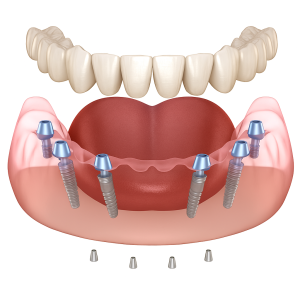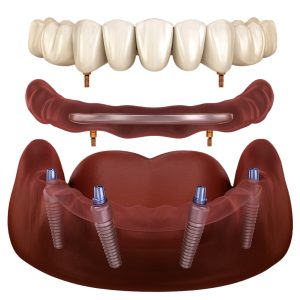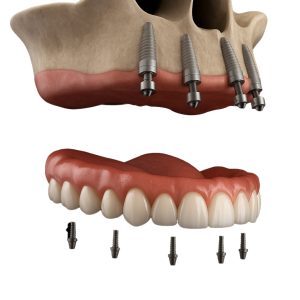All-on-X vs All-on-4: Understanding the Key Differences in Full-Arch Implantology
For dentists and specialists exploring advanced full-arch restoration techniques, the terms All-on-4 and All-on-X frequently come up. While both are life changing solutions for edentulous patients, there are important distinctions that impact treatment planning and outcomes.
In this guide, we break down the differences between the two help you make informed clinical decisions.
What is All-on-4?
The All-on-4 technique, developed in the late 1990s, involves placing four dental implants strategically in the jaw to support a full arch of prosthetic teeth. Two implants are placed vertically in the front, while two are distally inclined posteriorly to maximize bone contact and minimize the need for bone grafting. This approach is renowned for its cost-efficiency and predictable outcomes, particularly for patients with moderate bone loss.
What is All-on-X?
All-on-X is an evolution of the All-on-4 concept. Rather than limiting the number of implants to four, All-on-X allows clinicians to place as many implants as needed—typically between 4 and 6—to optimize stability based on the patient’s anatomical needs. This flexible approach provides greater adaptability in cases with severe bone resorption or when higher functional demands are expected.
Key Differences: All-on-X vs All-on-4
- Implant Flexibility
- All-on-4: Fixed at four implants per arch.
- All-on-X: Allows 4, 5, 6, or more implants depending on bone density and prosthetic requirements.
- Case Selection
- All-on-4: Best suited for patients with adequate anterior bone.
- All-on-X: Ideal for more complex cases, offering tailored implant distribution to enhance support.
- Long-Term Stability
- Adding more implants (as in All-on-X) can improve long-term load distribution and durability of the prosthesis.
- Surgical Planning
- Both techniques benefit from advanced full-arch guided surgery and surgical guides that improve accuracy and outcomes. However, the All-on-X workflow often requires more customized planning due to variable implant counts and positions.

The Role of Digital Technology in All-on-X and All-on-4
With the rise of digital dental design services, both All-on-4 and All-on-X have become more predictable and precise. CBCT imaging, CAD/CAM workflows, and custom surgical guides allow for pre-planned implant placement, ensuring a streamlined chairside experience and reduced complications.
At 3DDX, we support clinicians with a complete suite of digital tools, from guided surgery planning to the fabrication of high-precision guides and full-arch prosthetics. Our all-on-x solutions are designed to meet the demands of even the most complex cases, enabling optimal clinical outcomes with confidence. To learn more, visit All-on-X Solutions & Full-Arch Guided Surgery
Which Option is Best?
Choosing between All-on-4 and All-on-X depends on individual case factors, including bone volume, occlusal load, and patient-specific expectations. While All-on-4 remains a reliable and well-documented solution, All-on-X offers greater flexibility and potential benefits in select cases.
Final Thoughts
Whether you’re placing four implants or more, success hinges on precise planning and execution. Leveraging digital dental design services and advanced surgical guides is key to elevating your full-arch restorations. At 3DDX, we are committed to helping clinicians deliver outstanding results with state-of-the-art solutions tailored to every patient’s needs.

 Support
Support FINE-TUNE
FINE-TUNE ORDER SERVICES
ORDER SERVICES PRODUCT SHOP
PRODUCT SHOP 1-866-834-7925
1-866-834-7925







